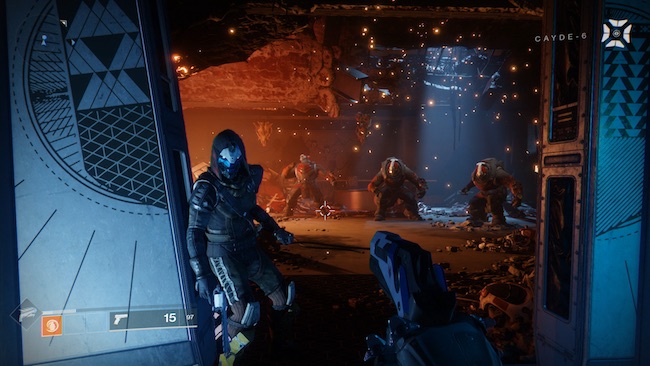
To say the original Destiny had an underwhelming launch is quite an understatement. Bungie’s supposed CoD killer was light on content, heavy on tedious grinding, and had a story that didn’t have time to explain why it didn’t have time to explain. While many of the wrongs were righted over the course of numerous updates and expansions, gamers had the right to be sceptical about the sequel when it was announced earlier this year. As someone who jumped on and off Destiny throughout its life cycle, I was optimistic that Destiny 2 would hook a larger audience and keep people playing for longer. Sometimes it gets a bit repetitive, but Bungie has proven that the idea of Destiny is more than just a proof of concept.

One thing vanilla Destiny was widely criticised for was the lack of a cohesive and engaging story unless you spent your time reading up on the lore. It seems like Bungie really honed in on fixing this issue because Destiny 2’s plot is simple but well told with entertaining and developed characters. The narrative takes place sometime after Destiny’s Rise of Iron expansion where the main headquarters of all guardians, The Tower, is attacked by the Red Legion. The Red Legion is a faction of Cabal (basically aliens from Mars) led by Dominus Ghaul. For those unfamiliar with vanilla Destiny’s context, an alien structure visits earth from space, which leads to a golden age. However, the structure eventually dies and entrusts the power of light to particular inhabitants of the earth. This is important because Ghaul believes that the light belongs to him and the Cabal. After completely decimating the tower and many guardians in the process, it’s your job to play a part in regrouping, reorganising, and taking the fight to Ghaul to claim back what is rightfully yours.
It sounds like a simple premise, and that’s because it is, but it’s told very well. The main cast is excellently voice acted, with Nathan Fillion as Cayde, Lance Reddick as Zavala, and Gina Torres as Ikora Rey, the three vanguard heads are explored in greater detail here. Zavala, in particular, goes through quite a bit of character development, and it left me eager to see what they plan to do with the others in future expansions. It’s all brought together by high-quality cinematic cutscenes that create a level of immersion that was nowhere to be found in the first game. It’s a pleasant surprise if you enjoy a decent narrative, and while it doesn’t break any boundaries, it’s certainly well told and engaging.

I didn’t have any concerns about Destiny 2’s gameplay up until I played the beta. I felt that the cool-downs on abilities took far too long and made for an overall slower experience. Thankfully, Bungie listened to the community and made some adjustments, making the core gameplay loop extremely robust. Shooting feels great, weapons are responsive, and the game is extremely polished as a general rule. Bungie seems to prove time and time again that they know how to make a satisfying shooter, and Destiny 2 is no exception. You start off by creating a Guardian and picking one of three classes: Hunter, Warlock, or Titan. If you played the original Destiny, all of your custom characters carry over, meaning you can opt to choose them if you wish. Each class has three subclasses that specialise in an element. Each subclass feels unique and suited to specific situations, and swapping between them on the fly as you jump from activity to activity is of the utmost importance. It makes each class feel like it’s worth picking, and while there are some that obviously outshine others, it doesn’t mitigate the fact that each has their own applications.
The major factor that deterred most players from Destiny was the grind that was required to grow in power. More often than not, it was a tedious struggle that was almost never in favour of the player. A lot of the issues that caused this were overhauled through expansions and the newly established levelling system that was put in place by the end of Destiny’s life cycle has made it through to Destiny 2 with some added improvements. Once you finish the campaign and hit the level cap of 20, you’ll start to look to improve your Power Level. Your Power Level is separate to your main level and is determined by the average power of all your gear. With the Power Level currently capped at 305, a lot of time can be sunk into Destiny 2 trying to max out characters, but it’s no longer a chore to do so.

No matter what you choose to do when you hop onto Destiny 2, you’re constantly being rewarded with new gear, which is usually stronger than the gear you already have. Completing many of the numerous strikes, playing competitive multiplayer, hunting for public events or even trying your hand at the raid all reward you with sweet, sweet loot, and it’s tough not to get hooked on it. I found I was never bored of what I was doing because once I got tired of doing one thing, I knew I could move to another and still get rewards for it.
The PvP content feels well balanced at the moment, and it seems like a healthy meta is already forming around Crucible and the more competitive Trials of the Nine. All of the strikes are well designed, especially the first time you play through them, but they do eventually become a little stale after playing them multiple times. The most daunting challenge in the game comes in the form of the raid, which dropped a week after the game’s release. For the uninitiated, raids are six man activities that take the mechanically driven formula of strikes and dials it up to eleven. The first of many, Leviathan, is extremely challenging and demands precision, teamwork, and communication if you want to prevail and reap the rewards. While the raid is one of the highest level activities in the game, it’s also one of the most engaging and entertaining to play. This is arguably the best raid that Bungie has designed thus far, but in the end, it comes down to personal preference.

Every other activity can be played in three-man groups, bar some of the multiplayer modes which are four-man activities. Most of the main campaign can also be played entirely cooperatively, all the strikes can be played with teams of three, and the open worlds of each planet can be explored with up to three people too. If you don’t have people to play with, that’s okay, because Destiny 2 has introduced a few new systems to help with that. First and foremost, Bungie has made it easier for clans to grow, meaning that groups are always looking for new members to further expand. If you’d prefer to stay as a lone wolf, you can utilise the Guided Games system which allows you to search for a group who can Sherpa you through high-level activities. It’s an excellent introduction to the game that really helps tighten the gap between new and veteran players when it comes to high-end activities.
There’s no denying that Destiny was an incredibly good looking game, and it carries over to Destiny 2 in a seemingly flawless fashion. While the game runs at 30 frames per second on consoles, the textures and attention to detail in these environments are simply incredible. Character, enemy, and weapon models all look excellent. The four planets you visit all feel unique; each with their own aesthetic, colour pallet, and environments to explore. Planets like Nessus and Titan, in particular, are standouts, and sometimes I find it hard not to gawk at Titan’s ominous electric ocean or Nessus’s dystopian and half terraformed structures. Destiny 2’s soundtrack is also another win, although a rather expected one. With Michael Salvatori composing the score, each track feels suited to the situation it plays in. It’s filled with deep vocals, and heavy use of a full instrumental ensemble, which really makes for some epic, heart-pounding moments in the right situation. It’s not exactly a surprise after Destiny’s solid soundtrack, but that doesn’t mitigate it’s undeniably high quality.

It’s clear a lot of people have been on the fence about Destiny 2 and with good reason. After Bungie failed to deliver on what Destiny was supposed to be, the sour taste left in the mouths of many gamers acted as an instant turn off for the sequel. That is not the case this time around, though. In fact, Destiny 2 serves as a shining example of developers listening to player feedback. While the story is simple, it’s well-told with a cinematic immersion that’s unrivalled by other first-person shooters in recent memory. You almost always feel like your time isn’t wasted as you’re consistently rewarded with more powerful gear; all of which is quite well balanced alongside each of the nine subclasses found in the base game. Not to mention, it’s all excellently rounded off with high-quality visuals, performance, and sound. Bungie have redeemed themselves, and, in turn, shown that Destiny is a franchise that’s going to firmly establish itself alongside the behemoths of the genre. I for one can’t wait to see how it continues to develop over the coming years.











